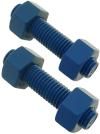The VCFS fire resistant gasket combines proven sealing performance in aggressive environments with the capability to pass the API 6FB, 3rd Edition fire test.
Due to its unique pressure activated sealing mechanism, the heat resistant gasket requires far less bolt stress to seal than other gasket types. In addition, the engineered E-ring will serve as a secondary seal during normal operation and the primary sealing element during a fire.
* Note: The “FS” or “Fire Safe” designation denotes only that this gasket has successfully passed the API 6FB fire test. Due to the fact that every fire is unique and many uncontrolled variables are present, no other claims regarding suitability or performance in a fire are made. Each designer, user and/or operator will need to assess their individual situation when deciding to install FS style gaskets. Covered under patents 266755, 7976074, 2271866.
Features and Benefits
- Maintains seal while subject to a 1500° fire
- Extremely high reliability sealing and insulating for all critical services
- Seals and insulates at all pressures up through ANSI 2500# and API 5000#
- Withstands severe service conditions, including large bending moments, vibration, temperature and pressure cycling
- Withstands corrosive environments, including high concentrations of CO2, H2S, produced water, etc.
- Outstanding insulation properties for cathodic protection
- Pressure activated for reliable sealing and eliminating costly leaks
- Precisely sized to the bore to protect flange faces from media-induced corrosion and flow-induced erosion. Prevents turbulent flow at flanged connections
- Eliminates Microbially Induced Corrosion (MIC)
- Mitigates galvanic corrosion in dissimilar metal flanges
- Insulating Kits (sleeves and washers) always include high strength double washers and full-length sleeves for maximum assurance against short circuits
- High strength laminate material resists failure due to excess compression (i.e., over tightening bolts)
- Spring energized PTFE seal provides radial load and encapsulation in the seal groove to eliminate cold flow
- Available to match any flange specification (ANSI, API, BS, DIN, AS, others)
- Can seal mismatched RTJ Flange with Raised Face Flanges
Installation
- Easy installation, make up and removal
- Low required bolt loads.
- Less make-up force is required resulting in less flange and bolt stress.
- Self-aligning and centering
- No special tools required.
Tandem seal versions available - contact GPT engineering for size availability
Patent numbers 266755, 7976074, 2271866
Applications
- Fire-safe flange insulation in conjunction with cathodic protection
- Insulation between dissimilar metals to prevent galvanic corrosion
- Wellhead isolation from inter-connected flow lines
- Valve connections
- Christmas Tree connections
- Pump connections
- Compressor connections
- Mating mismatched ring-joint to raised-face flanges (VCFS will seal in ring-joint, raised-face and flat face/slip-on flanges)
- Eliminate fluid trap corrosion between ring-joint (RTJ) flanges where high concentrations of CO2, H2S and other aggressive hydrocarbon media are present
- Eliminate turbulence and flow-induced erosion between ring-joint (RTJ) flanges.
- To seal between flanges subjected to vibration/cavitation (i.e., compressor stations).
Specifications
G-11 NEMA LI1 grade G-11 Glass-Reinforced Epoxy (GRE) laminate material:
- Ring type joint (RTJ) flanges from 2”- 36” (50mm - 920mm)
- Raised face flanges from 1”- 36” (25mm - 920mm)
- Compressive Strength: 65,000psi
- Dielectric Strength: 750-800 VPM
- Water Absorption: 0.05%
- Tensile Strength: 50,000psi
One isolating and sealing gasket, VCFS Type “F”, 0.260” thick or .308” thick, 316 stainless steel core retainer laminated on both sides with a G-10 fiber glass reinforced laminate containing a precision tapered groove to accommodate the controlled compression of a PTFE spring energized seal. Another groove shall contain a carbon steel backup ring with Halar® coating and an Inconel® E-ring coated with PTFE. Sealing element placement shall accommodate either flat, raised or RTJ face flanges. The PTFE seal shall be spring and pressure energized. The G-10 retainer shall have a 800 volts/mil dielectric strength and a minimum 65,000 psi compressive strength. The I.D. of the flange isolating gasket shall match the bore of the flange in which it is installed. Product have passed API 6FB fire testing.
Note: Electrical values are based on laboratory conditioned samples in laboratory conditions. Exposure to moisture or elevated temperature will change values.
 Studs and nuts available upon request with all kits
Studs and nuts available upon request with all kits

